Fall is the best time for planting trees, but you might be getting cold feet about planting trees in a garden with wet feet. It's easy to find drought-tolerant trees these days, but for those of us in areas that are flood prone or have soggy soil, the choices are more limited. If you lack the "well-drained soil" that every plant seems to require, the solution is to plant native trees that can be found living naturally in the swamps and floodplains of the United States. From evergreens to fruit trees, nuts and fall color, there's a solution for every soggy site.
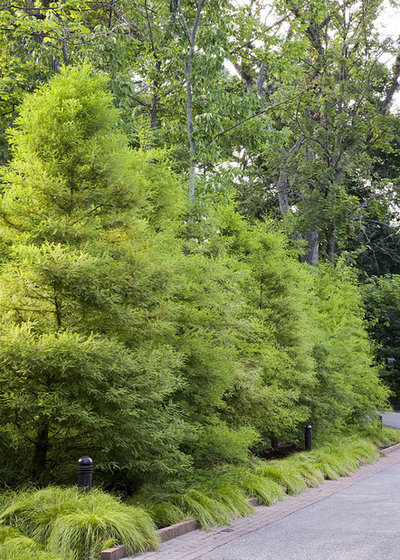
The Garden Consultants, Inc.
Bald Cypress (
Taxodium distichum, USDA zones 5 to 10; find your zone) is the king of flood-tolerant trees and can be found growing directly in standing water throughout Southeastern swamps, from North Carolina to extreme southeast Florida. They're also drought tolerant once established, so they're often used in a wide variety of commercial plantings — anywhere from retention ponds to parking lot medians. Cypresses are known for developing buttressed trunks and knobby roots that protrude from the soil, but they'll keep their roots below the soil as long as floods aren't frequent.
Pond cypress (
Taxodium ascendens, zones 5b to 9b) is similar to bald cypress, but its smaller size makes it ideal where space is a concern.
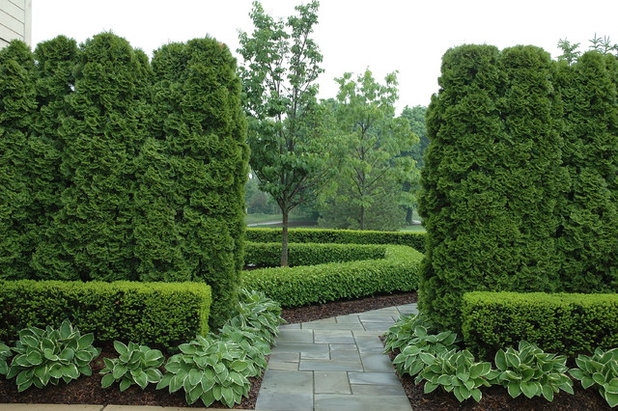
Land Architects, Inc.
Arborvitae (
Thuja occidentalis, zones 3 to 7) is a standby for hedges and windbreaks with its neat, symmetrical form and tightly packed needles, making it ideal for giving a formal look to poorly drained gardens. Though it's native from Manitoba and Minnesota through Quebec, there are isolated populations as far south as North Carolina. One of arborvitae's biggest draws is its variability; with some forms topping out at a mere 3 feet tall and others reaching a lofty height of 60 feet. Unless you're planting a dwarf cultivar, be sure to plant arborvitae well away from driveways, buildings, sidewalks and any other structures that they might eventually lift with their massive trunk and twisted roots.
If you're after an evergreen with glossy leaves and bright red wildlife-attracting berries, look no further than the hollies.
Yaupon holly (
Ilex vomitoria, zones 7 to 10) and
dahoon holly (
Ilex cassine, zones 7 to 10) are excellent choices for the Southeast, while
American holly (
Ilex opaca, zones 5 to 10) will grow throughout most of the United States.
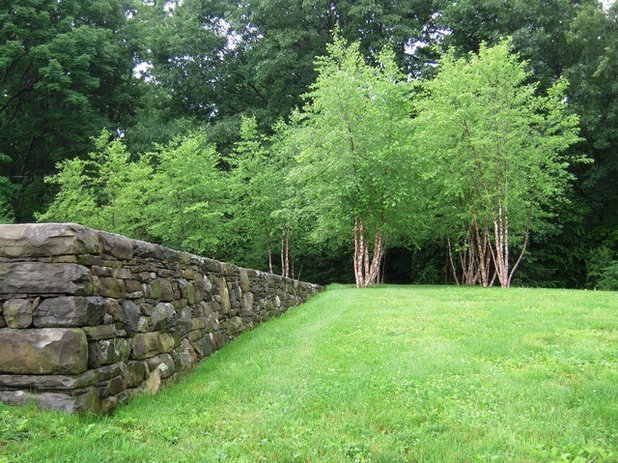
ADRIAN SMITH - Landscape Architecture
River birch (
Betula nigra, zones 3 to 9) is a fast-growing tree that loses its leaves in fall to reveal a beautiful framework of white branches and multiple trunks. It's native to much of the eastern United States, from Minnesota through Texas and Florida. Plant them in naturalistic groves against dark backdrops, or plant one by itself with a ground cover at the base to highlight the colorful peeling bark. Unlike most birches, river birch is tolerant of the heat and humidity that abounds in the muggy Southeast.
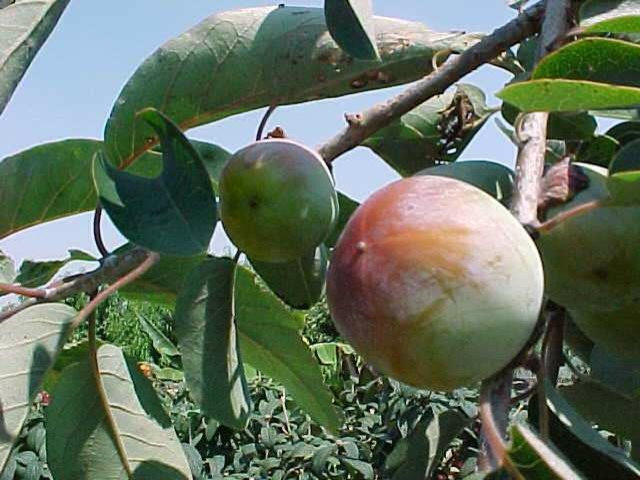
Missouri Botanical Garden
American persimmon (
Diospyros virginiana, zones 4 to 9) is an astringent species of persimmon that needs to fully ripen before you can eat it, but it's well worth growing for its tolerance of wet soil and its value as a wildlife attractor. After all, how many other fruit trees can tolerate poor drainage? American persimmons do provide fall color, but the leaves are soon overshadowed by the bright orange globes of fruit that persist after the last leaves have dropped, right into winter. You can find them growing naturally throughout most of the eastern United States, from Kansas through Florida.
Paw paw (
Asimina triloba, zones 5 to 9) is yet another native fruit that tolerates wet soil, but it is most commonly seen growing as a shrub. The fruit has a creamy texture like that of its custard apple relatives and a flavor that some would compare to that of a banana.
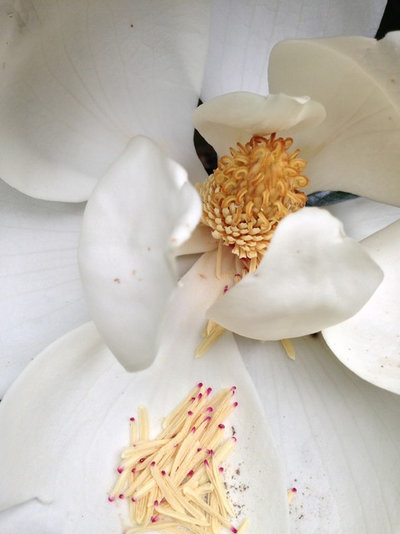 Southern magnolia
Southern magnolia (
Magnolia grandiflora, zones 6 to 10) is the queen of the South for it's intoxicatingly fragrant and enormous white flowers and its unique foliage: dark green and glossy with velvety rust-colored undersides. The species is so enormous and imposing that it should only be used in the largest spaces, but cultivars like 'Little Gem' remain small enough to be used in most gardens. Since it's native to floodplains from Texas through Florida and into Virginia, it goes without saying that the magnolia can withstand its share of occasional standing water.
Sweetbay magnolia (
Magnolia virginiana, zones 6 to 9) can handle even soggier soil, and can be found growing in permanently boggy swamps of the Southeast. Its only drawback is that it temporarily loses its leaves in winter.
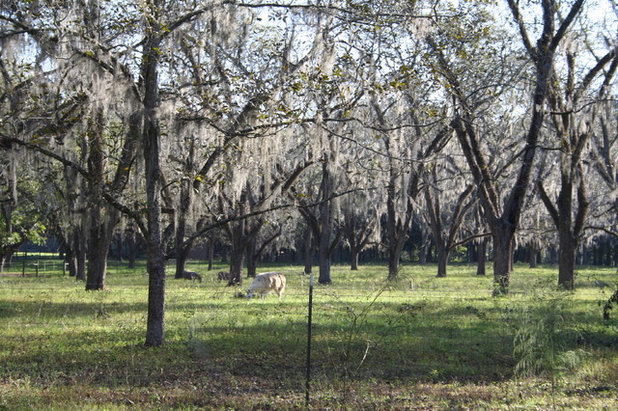 Pecan
Pecan (
Carya illinoinensis, zones 6 to 9) does require well-drained soil for the majority of the year, but it will tolerate floods and temporary standing water, as it is also native to the floodplains of the Southeast, from southern Illinois to Texas and Louisiana. The pecan tree's tasty nuts are only one reason to add it to your landscape, as it is an immensely attractive tree with arching branches and finely divided bright green leaves.
Other trees in the
Carya genus are known as hickories, and most will handle soggy soil even better than the pecan, but you must have a lot of space;
Shagbark (
Carya ovata, zones 4 to 8) and
pignut hickory (
Carya glabra, zones 5 to 9) can reach anywhere from 50 to 100 feet tall.
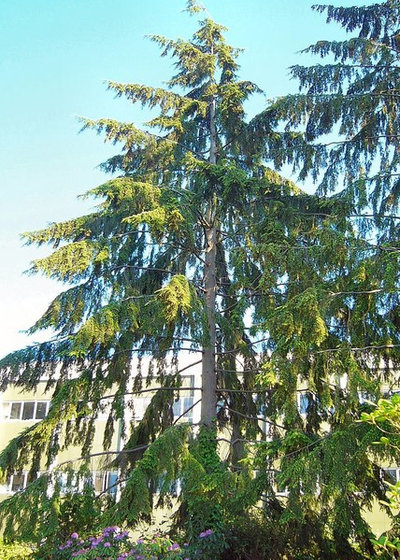 Western hemlock
Western hemlock (
Tsuga heterophylla, zones 6 to 9) is a good choice for those of you in the Pacific Northwest, since it can be found in riparian forests from California all the way up the West Coast to Alaska. It can ultimately grow to become a massive evergreen tree, reaching 70 to 200 feet tall, but don't expect it to do so in your lifetime.
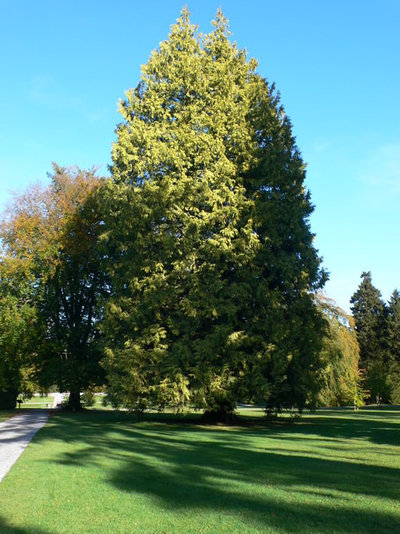 Western redcedar
Western redcedar (
Thuja plicata, zones 5 to 9) is yet another tree for soggy gardens out West, but it can also be grown in the western Rockies, where it's also native. This evergreen conifer is a fast grower and will eventually reach 50 to 70 feet tall, so plant it where it will have room to breathe!





